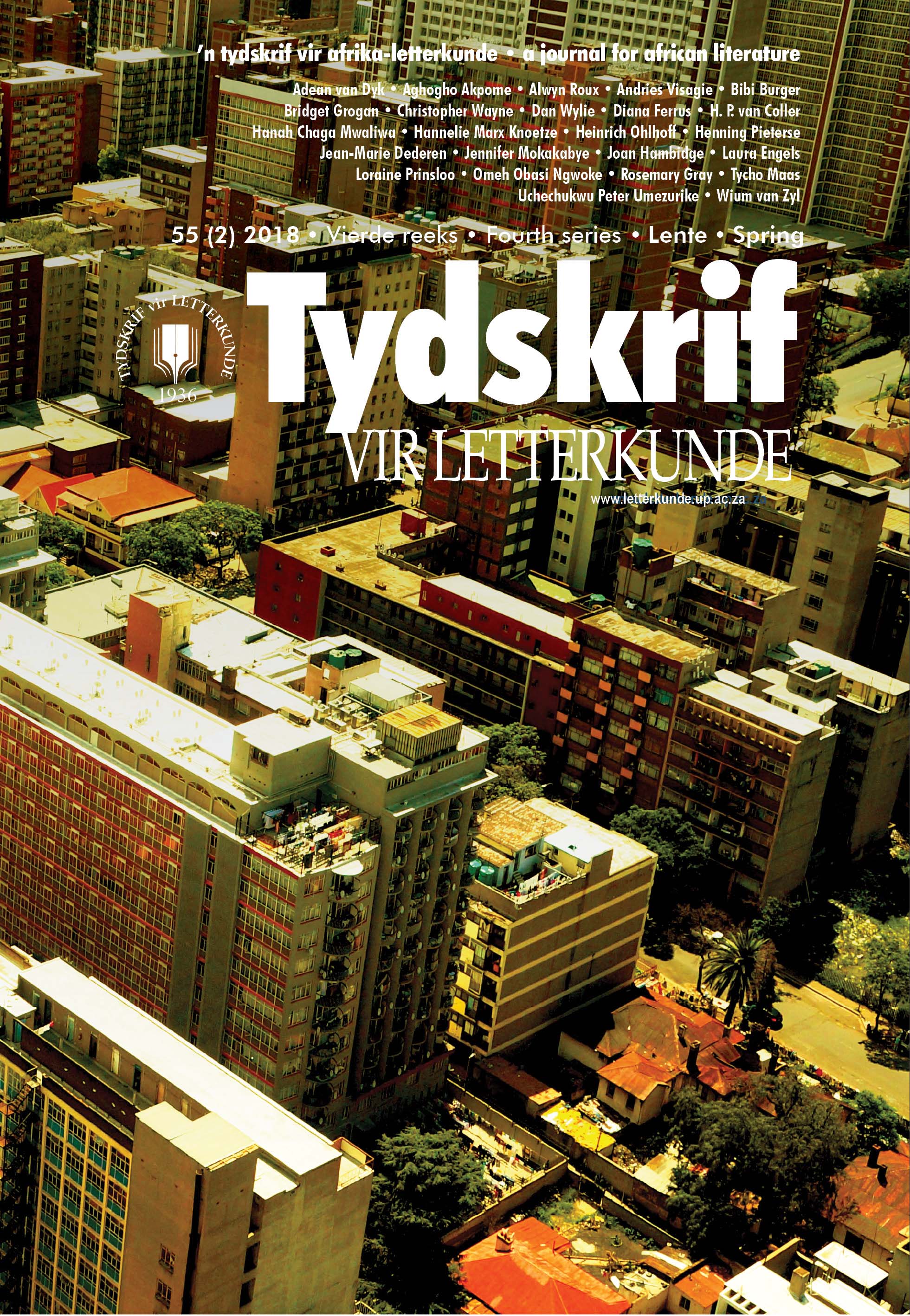Redreaming ways of seeing: Ben Okri’s intuitive creativity
DOI:
https://doi.org/10.17159/2309-9070/tvl.v.55i2.2256Keywords:
dreaming soul, intuitive creativity, Ben Okri, psyche, The Landscapes WithinAbstract
Drawing on A Way of Being Free (1997) and A Time for New Dreams (2011) among other Okrian texts, this article is a discussion of the notion of redreaming ways of seeing through intuitive creativity. The argument is divided into three parts: the role of intuitive creativity; redreaming ways of seeing in The Landscapes Within (1981); and intuition or “the landscapes within”. The deployment of John Berger’s Ways of Seeing and Roland Barthes’s Image, Music, Text posits an Afro-Western worldview in which the title of Okri’s second novel effectively becomes a simulacrum for the lead character’s psyche that supplants character per se, so that the “landscapes within”—the psyche—becomes the eponymous hero of the tale. The contention is that the complex inner workings of the mind of the artist-protagonist, Omovo, is both the signifier and the signified. This is supported by analyses of an Okri poem and extracts from the novel. I argue that, in contrast to its inter-art variants, René Magritte’s 1935 Le faux miroir and La clef des songes, the novel invokes a neo-Platonic/Coleridgean concept of the “enlightening” eye as a correlative of Okri’s notion of the inward visionary quest of the dreaming “soul” “opening towards infinity”. The article concludes by briefly justifying the article’s claim that, in this novel, art deals with inner reality, with “the landscapes within”
Downloads
References
Bargna, Ivan. African Art. Java, 2000.
Barthes, Roland. Image, Music, Text. Hill and Wang, 1977.
Berger, John. Ways of Seeing. Penguin Modern Classics, 2008.
Camus, Alfred. The Myth of Sisyphus and Other Essays. Trans. Justin O’Brien. Random House, 1983.
Chadwick, Charles. Symbolism. Methuen, 1973.
Coleridge, Samuel Taylor. Aids to Reflection. Aphorism IX, ed. Henry Nelson Coleridge. Chauncey Goodrich, 1840, pp. 161–210.
Gray, Rosemary. “Apologia pro Ben Okri’s In arcadia: A neglected masterpiece?” English Academy Review vol. 26, no. 1, 2009, pp. 41–52.
Gray, Rosemary. “Divinatory simulacra in the novels of Margaret Atwood.” Myths. rites, simulacra: Semiotic viewpoints. ed. by Jeff Barnard and Gloria Withalm. Die Deutschen Bibliothek, 2000, pp. 853–6.
Gray, Rosemary. “Ontopoiesis in Ben Okri’s poetic oeuvre and A Time for New Dreams.” ed. Anna-Teresa Tymieniecka, “Phenomenology of Space and Time.” Analecta Husserliana vol. CXVI, 2014, pp. 49–58.
Gray. Rosemary. “The creative imagination in Ben Okri’s The Landscapes Within (1981).” English Academy Review: Southern African Journal of English Studies vol. 30, no.2, 2013, pp. 21–31.
Gray, Rosemary. “When chaos is the god of an era: Rediscovering an axis mundi in Ben Okri’s Starbook (2007).” Research in African Literatures vol. 44, no. 1, 2013, pp. 128–45.
Hughes, Ted. New Selected Poems 1957–1994. Faber, 1995.
Jowitt, David. “Review of Dangerous love.” Wasifiri vol. 24, 1996, pp. 62–3.
Jung, Carl Gustav. Letter to Fanny Bowditch. 22 October 1916. Carl Jung Depth Psychology. 8 Feb. 2018. . Accessed 18 May 2018.
Kundera, Milan. The Art of the Novel. Faber and Faber, 1988.
Maithufi, Sope. “The Inward and Outward Trajectories of the Shaman’s Journeys: Mediati-on
in Ben Okri’s Dangerous Love and Zakes Mda’s The Sculptors of Mapungubwe.” Journal of Literary Studies vol. 32, no. 2, 2015, pp. 81–93.
Maya-Pearce, Adewole. A Mask Dancing. Hans Zell, 1992.
Mooney, Bel. Review of In Arcadia. The Times 2002
Ntuli, Pitika. Pitika Ntuli: Scent of Invisible Footprints. U of South African P, 2010.
Okri, Ben. A Time for New Dreams. Random House, 2011.
Okri, Ben. A Way of Being free. Phoenix, 1997.
Okri, Ben. Dangerous Love. A. D. Donker, 1996.
Okri, Ben. In Arcadia. Phoenix, 2002.
Okri, Ben. The Age of Magic. Head of Zeus, 2014.
Okri, Ben. The Landscapes Within. Longman, 1981.
Okri, Ben. The Mystery Feast. Clairview, 2015.
Okri, Ben. Wild. Random House, 2012.
Richards, I. A. Plato’s Republic. Cambridge U P, 1996.
Ross, Jean. “Contemporary authors interview (with Ben Okri).” Contemporary Author vol. 138, ed. Donna Olendorf. Gale Research, 1993, pp. 337–8.
Rowley, George. Principles of Chinese painting. Princeton U P, 1947.
Schama, Simon. Landscapes and Memory. Harper Collins, 1995.
Severac, Alaine. “Dangerous love: Okri’s metafiction.” Theory and Literary Creation/Théorie et création littéraire, ed. Jean-Pierre Durix. Editions Universitaires de Dijon, 1999, pp. 175–85.
Smith, Anna. “Dreams of cultural violence: Ben Okri and the politics of the imagination.” World Literature Written in English vol. 38, no. 2, 2000, pp. 44–54.
Sylvester, David. Magritte. Thames and Hudson, 1992.
Tolle, Eckart. The Power of Now. Hodder & Stoughton, 2005.
Tunca, Daria. “Ben Okri’s The Landscapes Within and Dangerous Love: Vision and revision.” BELL: Belgium Journal of English Language and Literatures vol. 2, 2004, pp. 85–101.
Tymieniecka, A-T, ed. “Aesthetic expression of the moral sentiment.” Phenomenological Inquiry vol. 28, 2004, pp. 5–35.
Tymieniecka, A-T. “Phenomenology of Space and Time.” Analecta Husserliana. vol. CXVI, 2014, pp.
–36.
Wilkinson, Jane. Talking to African Writers. James Currey, 1992.
Wright, Derek. New Directions in African Fiction. Twayne, 1997.
Downloads
Published
Issue
Section
License
Copyright (c) 2018 Tydskrif vir Letterkunde

This work is licensed under a Creative Commons Attribution-ShareAlike 4.0 International License.


 https://orcid.org/0000-0001-6465-6584
https://orcid.org/0000-0001-6465-6584


.png)